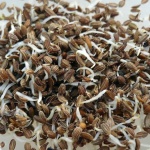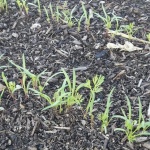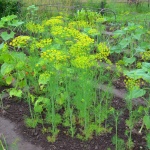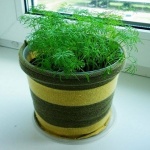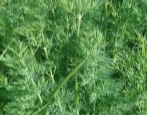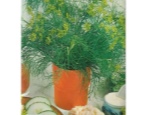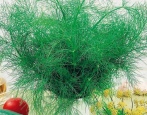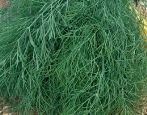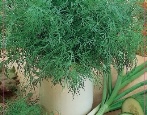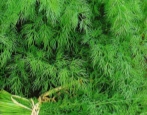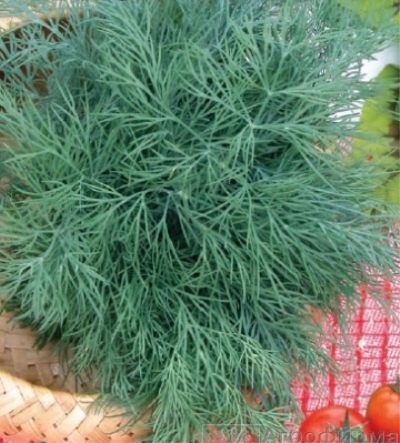
- Authors: Kononov A.N.
- Year of approval: 2002
- Leaf rosette: half-raised
- Ripening terms: mid-season
- The period from germination to biological ripeness (harvesting with spices): 86 days
- Foliage: strong
- Leaf size: large
- Leaf color: grayish green with a strong waxy bloom
- Dissection of leaves: medium
- Plant height in the flowering phase, cm: 150-160
Yielding and fragrant dill Mammoth is a popular variety of Russian selection, suitable for growing in a garden or in a container on a windowsill, balcony. Plants are distinguished by a rapid rise in height, lush greenery. According to the content of essential oils and aromatic substances, the variety is considered one of the most useful.
Breeding history
The mammoth was obtained by the breeder A. N. Kononov. Included in the State Register after variety trials in 2002. The applicant was the "Association Biotechnics" from St. Petersburg, representing the regional public organization "Union of Seed Producers".
Description of the variety
Dill is versatile, unpretentious, with a friendly emergence of shoots. Designed for planting in open ground. Stems form slowly. It is formed according to the bush type. The harvested crop is suitable for transportation and storage after harvest.
Characteristics of the appearance of the plant
Bushes with a straight, strong stem and a half-raised rosette of leaves. The greens are dense, intensively growing. Strong branching. The leaves of this dill are large, grayish-green, with a pronounced waxy bloom, medium dissected. The height of the dill Mammoth reaches 150-160 cm in height.
Umbrella is large, inflorescences are laid late. During harvesting for greens, the weight of the plant is 7-8 g, at the stage of biological maturity 21-24 g.
Purpose and taste
Dill is suitable for fresh consumption, salting and pickling, drying. Valuable essential oils are obtained from seeds and other parts of the plant. The greens of the Mammoth variety are juicy and tender, very pleasant to the taste, have a delicate and bright aroma.
Ripening terms
The variety is mid-season. Harvesting for greens is done 42 days after germination. On the spice, dill of this variety is grown longer, up to 86 days, when it enters the stage of biological ripeness. Harvesting is extended, can be done from May to September.
Yield
Mammoth belongs to the high-yielding varieties of dill. On average, when planting on greens, about 1.7 kg of shoots and up to 3.1 kg of seeds of future spices are removed from 1 m2.
Growing regions
The variety is suitable for planting in most regions of Russia. It is planted in the North Caucasus and Siberia, in the Urals and in the Central Black Earth Region. Cultivated in the Volga region and in the North-West.
Growing and care
Plants are best placed in a sunny location. Sowing is performed directly into the ground, to a depth of 1-2 cm, according to the 20 × 5 cm scheme. To obtain greens in a continuous mode, it is done repeatedly, from April 20 to August 15, with an interval of 15-20 days.
The variety is sensitive to care. Dill Mammoth needs regular watering, quite often, especially in the absence of precipitation. Be sure to loosen the soil in the aisles, weed out weeds. Before digging, it is recommended to add nitroammophoska or superphosphate to the ground. It is better to mulch the soil surface with a layer of peat immediately after sowing.
In the stage of active growth of green mass, plants will benefit from top dressing with the preparation "Zircon" or "Epin". So the quantity and quality of the crop will be higher. All feeding is stopped 3-4 weeks before harvest. Nitrogen fertilizers are not used for these plantings.
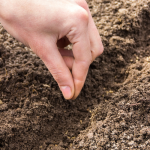
Dill cultivation is available in any conditions: open and closed ground, on a balcony or windowsill. Before planting dill, you need to carry out pre-sowing seed treatment, correctly determine the timing, prepare the beds.
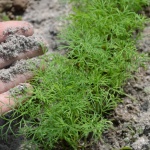
Soil requirements
For planting this dill, it is recommended to choose light fertile soils saturated with moisture. Loam and sandy loam, cultivated, with a neutral acidity level are suitable.
Required climatic conditions
Mammoth is a cold-resistant dill. It is successfully grown in unfavorable climatic conditions.
Disease and pest resistance
Plants are practically not affected by typical diseases of garden crops. But do not neglect pre-sowing seed treatment. Bushes of this variety are rarely affected by pests. In this case, they are sprayed with chemical insecticides. The main danger is posed by root aphids that enter the soil through seeds, a contaminated tool.
Review overview
Dill Mammoth has received numerous positive reviews since its launch. The variety is praised for the rapid growth of green mass, high quality seed material, friendly emergence of seedlings. The mammoth is not afraid of bad weather, strong shoots can even withstand hail. Plants are also suitable for planting in a pot, container, but they need a lot of free space around.
This variety is highly praised as an additive to salad, when used in marinades, pickles, freezing and drying well. On fertilized soils, the plant easily and quickly produces abundant greenery throughout the season. In the middle lane, they manage to collect 3-4 crops in a row.
Some summer residents refer to the disadvantages of the variety as a weak density of greenery. And also, not everyone likes the slow development characteristic of the Mammoth. It is noted that dry soil is poorly suited for this dill; there is no need to wait for a bountiful harvest on it.
